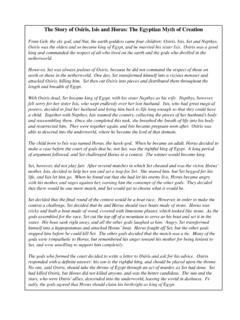Transcription of Visual Pleasure and Narrative Cinema Laura Mulvey
1 Visual Pleasure and Narrative Cinema Laura Mulvey [This article originally appeared in Screen 16:3 (Autumn 1975), 6-18.]. Introduction (a) A Political Use of Psychoanalysis This paper intends to use psychoanalysis to discover where and how the fascination of film is reinforced by pre-existing patterns of fascination already at work within the individual subject and the social formations that have molded him. It takes as a starting point the way film reflects, reveals, and even plays on the straight, socially established interpretation of sexual difference which controls images, erotic ways of looking, and spectacle.
2 It is helpful to understand what the Cinema has been, how its magic has worked in the past, while attempting a theory and a practice which will challenge this Cinema of the past. Psychoanalytic theory is thus appropriated here as a political weapon, demonstrating the way the unconscious of patriarchal society has structured film form. The paradox of phallocentrism in all its manifestations is that it depends on the image of the castrated woman to give order and meaning to its world. An idea of woman stands as lynch pin to the system: it is her lack that produces the phallus as a symbolic presence, it is her desire to make good the lack that the phallus signifies.
3 Recent writing in Screen about psychoanalysis and the Cinema has not sufficiently brought out the importance of the representation of the female form in a symbolic order in which, in the last resort, it speaks castration and nothing else. To summarize briefly: the function of woman in forming the patriarchal unconscious is twofold, she first symbolizes the castration threat by her real absence of a penis and second thereby raises her child into the symbolic. Once this has been achieved, her meaning in the process is at an end, it does not last into the world of law and language except as a memory, which oscillates between memory of maternal plenitude and memory of lack.
4 Both are posited on nature (or on anatomy in Freud's famous phrase). Woman's desire is subjected to her image as bearer of the bleeding wound. She can exist only in relation to castration and cannot transcend it. She turns her child into the signifier of her own desire to possess a penis (the condition, she imagines, of entry into the symbolic). Either she must gracefully give way to the word, the Name of the Father and the Law, or else struggle to keep her child down with her in the half-light of the imaginary. Woman then stands in patriarchal culture as signifier of the male other, bound by a symbolic order in which man can live out his fantasies and obsessions through linguistic command by imposing them on the silent image of woman still tied to her place as bearer of meaning, not maker of meaning.
5 There is an obvious interest in this analysis for feminists, a beauty in its exact rendering of the frustration experienced under the phallocentric order. It gets us nearer to the roots of our oppression, it brings an articulation of the problem closer, it faces us with the ultimate challenge: how to fight the unconscious structured like a language (formed critically at the moment of arrival of language) while still caught within the language of the patriarchy. There is no way in which we can produce an alternative out of the blue, but we can begin to make a break by examining patriarchy with the tools it provides, of which psychoanalysis is not the only but an important one.
6 We are still separated by a great gap from important issues for the female unconscious which are scarcely relevant to phallocentric theory: the sexing of the female infant and her relationship to the symbolic, the sexually mature woman as non-mother, maternity outside the signification of the phallus, the vagina. But, at this point, psychoanalytic theory as it now stands can at least advance our understanding of the status quo, of the patriarchal order in which we are caught. (b) Destruction of Pleasure as a Radical Weapon As an advanced representation system, the Cinema poses questions of ways the unconscious (formed by the dominant order).
7 Structures ways of seeing and Pleasure in looking. Cinema has changed over the last few decades. It is no longer the monolithic system based on large capital investment exemplified at its best by Hollywood in the 1930s, 1940s, and 1950s. Technological advances (16mm, etc.) have changed the economic conditions of cinematic production, which can now be artisanal as well as capitalist. Thus it has been possible for an alternative Cinema to develop. However self-conscious and ironic Hollywood managed to be, it always restricted itself to a formal mise- en-scene reflecting the dominant ideological concept of the Cinema .
8 The alternative Cinema provides a space for a Cinema to be born which is radical in both a political and an aesthetic sense and challenges the basic assumptions of the mainstream film. This is not to reject the latter moralistically, but to highlight the ways in which its formal preoccupations reflect the psychical obsessions of the society which produced it, and, further, to stress that the alternative Cinema must start specifically by reacting against these obsessions and assumptions. A politically and aesthetically avant-garde Cinema is now possible, but it can still only exist as a counterpoint.
9 The magic of the Hollywood style at its best (and of all the Cinema which fell within its sphere of influence) arose, not exclusively, but in one important aspect, from its skilled and satisfying manipulation of Visual Pleasure . Unchallenged, mainstream film coded the erotic into the language of the dominant patriarchal order. In the highly developed Hollywood Cinema it was only through these codes that the alienated subject, torn in his imaginary memory by a sense of loss, by the terror of potential lack in fantasy, came near to finding a glimpse of satisfaction: through its formal beauty and its play on his own formative obsessions.
10 This essay will discuss the interweaving of that erotic Pleasure in film, its meaning, and in particular the central place of the image of woman. It is said that analyzing Pleasure , or beauty, destroys it. That is the intention of this essay. The satisfaction and reinforcement of the ego that represent the high point of film history hitherto must be attacked. Not in favor of a reconstructed new Pleasure , which cannot exist in the abstract, nor of intellectualized unpleasure, but to make way for a total negation of the ease and plenitude of the Narrative fiction film.





